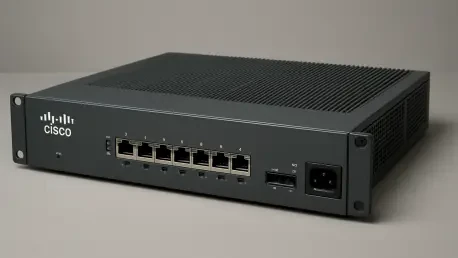Setting the Stage for AI-Driven Network Transformation
In an era where artificial intelligence (AI) is driving unprecedented computational demands, datacenter networks face a critical challenge: scaling infrastructure to support massive AI workloads without succumbing to power, space, or latency constraints. Imagine a world where millions of GPUs across continents operate as a single, seamless compute cluster, powering the next generation of AI innovations. Cisco’s latest offering, the 8223 Router, powered by the Silicon One P200 ASIC, steps into this arena with a bold promise of redefining connectivity through a staggering 51.2 Tbps capacity and long-range capabilities. This market analysis examines the potential of this router to reshape AI datacenter networking, delving into current trends, competitive dynamics, and future projections. The importance of such innovations cannot be overstated as industries race to harness AI’s potential, making robust, scalable networks a cornerstone of technological progress.
Deep Dive into Market Trends and Projections for AI Networking
Surging Demand for High-Speed, Distributed Datacenter Solutions
The datacenter networking market is undergoing a seismic shift, propelled by the explosive growth of AI applications such as generative models and large language processing. Traditional single-site datacenters are increasingly inadequate for handling the computational intensity required, pushing operators toward multi-site, distributed architectures. Market data indicates that the demand for high-bandwidth interconnects capable of linking datacenters over vast distances has grown by double digits annually since 2025, with projections suggesting continued expansion through at least 2027. Cisco’s 8223 Router, with its ability to connect sites up to 1,000 kilometers apart using 800 Gbps coherent optics, aligns directly with this trend, offering a solution to unify resources into massive AI training clusters.
Technological Innovations Driving Market Evolution
Beyond raw demand, technological advancements are reshaping the competitive landscape of datacenter networking. The introduction of routers like the Cisco 8223, boasting an aggregate bandwidth potential of three exabits per second, highlights a pivot toward scale-across solutions that mitigate power and capacity bottlenecks. Meanwhile, complementary innovations such as advanced optical interconnects and AI-optimized scheduling algorithms are emerging to address persistent issues like latency. Industry reports suggest that within the next three years, over 60% of large-scale datacenter operators will adopt distributed compute models, creating a fertile ground for products that can bridge geographic divides without sacrificing performance.
Competitive Dynamics and Market Positioning
Cisco is not navigating this market alone; competitors like Nvidia and Broadcom are also vying for dominance with their own high-capacity solutions. Nvidia’s Spectrum-XGS switches, already adopted by key players in the industry, focus on creating unified supercomputers across shorter ranges, while Broadcom’s Jericho4 offers 51.2 Tbps capacity for bridging up to 100 kilometers at over 100 Pbps. This diversity in approach underscores a fragmented market where different needs—long-range scalability versus short-range speed—drive adoption. Cisco’s strength lies in its long-distance connectivity, positioning it as a leader for operators with expansive, multi-regional footprints, though cost and latency challenges could temper its market penetration among smaller entities.
Analyzing the Economic and Operational Impacts
Cost Barriers and Scalability Challenges
While the technical capabilities of the Cisco 8223 Router are impressive, economic considerations play a significant role in market adoption. Deploying a network with thousands of these routers to achieve the full 51.2 Tbps capacity represents a substantial financial commitment, potentially limiting its appeal to only the largest enterprises like Microsoft and Alibaba, who are already exploring its P200 chips for datacenter interconnect networks. For smaller operators, Cisco’s scaled-down 13 Pbps configuration using a two-tiered network offers a more accessible entry point. Market analysis suggests that shared infrastructure models or vendor partnerships could emerge as viable strategies to offset costs, broadening access to such cutting-edge technology.
Latency as a Market Constraint
Latency remains a critical hurdle in the distributed networking market, even with high-speed solutions like the 8223 Router. A 1,000-kilometer connection introduces a baseline delay of approximately five milliseconds one-way, excluding additional lags from hardware components. This can disrupt real-time synchronization essential for AI training across clusters. However, ongoing research into strategic scheduling and model compression offers potential mitigations, which could influence market acceptance. Operators must weigh the trade-offs between geographic reach and performance, shaping how solutions are tailored to specific use cases within the AI ecosystem.
Adoption Trends Among Industry Giants
Interest from major cloud providers signals a positive market trajectory for Cisco’s innovation. Large-scale operators view the transition to P200-powered devices as a means to enhance stability, reliability, and scalability, moving away from traditional chassis-based systems. This reflects a broader industry shift toward flexible, high-performance architectures that can support the dynamic needs of AI workloads. Market forecasts predict that by 2027, over half of global cloud providers will integrate similar long-range interconnect technologies, creating a ripple effect that could drive standardization and further innovation in the sector.
Reflecting on Market Insights and Strategic Pathways
Looking back, this analysis reveals that Cisco’s 8223 Router marks a pivotal moment in the evolution of AI datacenter networking, addressing critical constraints through unprecedented bandwidth and long-range connectivity. The competitive landscape, with players like Nvidia and Broadcom offering alternative solutions, highlights the diverse needs within the market, while challenges such as cost and latency underscore the complexities of widespread adoption. For datacenter operators, the path forward involves strategic investments tailored to specific workload demands—whether opting for full-scale deployments or more modest configurations. Industry stakeholders need to prioritize partnerships and pilot programs to test multi-site setups, ensuring alignment with operational goals. Ultimately, the journey toward seamless, continent-spanning AI networks demands a balanced approach, leveraging innovations while navigating economic and technical hurdles to build a resilient infrastructure for the future.









